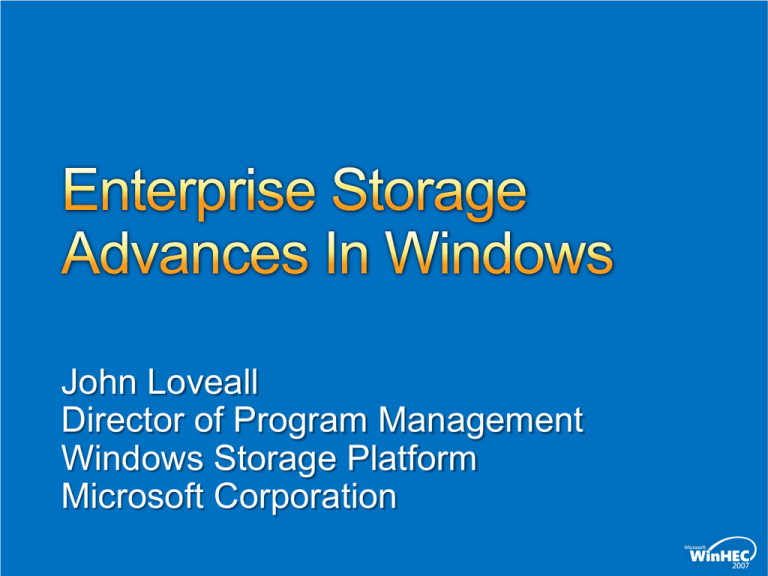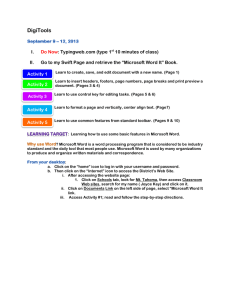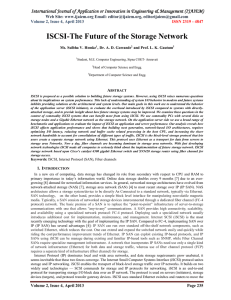
John Loveall
Director of Program Management
Windows Storage Platform
Microsoft Corporation
Provide details of Enterprise Storage
Stack Features planned for Windows
Server codenamed “Longhorn”
Highlight technology trends for
Enterprise Storage
Storage Trends
Microsoft MPIO Support
Server Storage Stack Changes
iSCSI Initiator Integration
Storage Management and APIs
Remote Boot Support
Server Backup
Changes in Online/Offline behavior
Technology Futures
Move toward stateless servers
Security/Key Management
Flash in the system
Broad SAN Adoption
Growing Adoption for Ethernet storage
Aggregates multiple ports for both block-level fail-over and
load balancing
Supports partner provided Device Specific Modules
(DSMs)
Microsoft DSM (msdsm) included inbox for storage arrays
that support either:
Active/Active
Asymmetric logical unit access (ALUA)
Protocol Independent
Supports SAS, Fibre Channel, iSCSI, Infiniband
Migration from Windows Server 2003 planned for RC1
Allows upgrade with multiple physical paths in place
MPCLAIM command line used for Windows “Server Core”
New mechanism included in Windows Server
codenamed “Longhorn” helps ensure that inbox Microsoft
MPIO binaries are not overwritten by MPIO binaries in
partner provided packages
MPIO Driver Development Kit
Includes sample source for a common DSM which can be compiled
for all platforms (Windows 2000, Server 2003, Windows Server
Longhorn)
Allows partners to ship a single DSM for multiple platforms
Includes handling persistent reservations (PR) for both Server 2003
and Windows Server Longhorn to comply with new Windows Server
Cluster Longhorn requirements
DSM installation
From control panel
configuration utility
From partner
provided integrated
installation
solutions
MPIO Becomes “Mainstream”
Program agreement not required for
Windows Server codenamed “Longhorn”
Program Agreement still available for
redistributing binaries on Windows Server
2003/Windows 2000 Server
Targeting availability of sample DSM
code through standard Windows Server
Longhorn development kit
Windows Server Longhorn
Storport Hardened for SANs
IO Timeout modified for BUSY Targets
Enables Long-Distance LUN Queue Handling
Full Support of MSI-X Enabled HBAs
Stabilization of Power Management
Handling
Virtual Miniports enabled for SAN
Diversity
iSCSI Miniport now a Storport Miniport
Windows Server Longhorn
ClassPnP
Improvements for Robust MPIO Deployments
Crashdump
Removed dependency on NTOS
Multipathing Support
Supports crashing to an alternate device
connected to any miniport driver
Disk
Unchanged – Extremely Stable
Internet Storage Name Service
Centralized Discovery of iSCSI devices
on an IP Storage network using the
iSNS protocol
Included in Windows Server
codenamed “Longhorn”
Installs as an optional component
Integrated inbox in Windows Server codenamed “Longhorn”
Enables block-based storage for wide area networks and high
throughput implementations
Suitable for applications requiring block level connectivity such as Exchange
Server and SQL Server
High Availability through Microsoft MPIO or MCS (multiple connections
per session)
Supports up to 256 Terabyte LUNs through GPT Disks
Chkdisk times for LUNs still a factor
Connections to iSCSI disks can be configured through:
Control panel configuration utility
Command line interface (iSCSICLI)
iSCSICLI used for “Server Core” Installations
Storage Explorer
Support for stateless servers booting using the Microsoft
iSCSI software initiator and standard (enterprise class)
NICs
Designed to support all Logoed iSCSI targets
Utilizes iSCSI boot firmware table (iBFT) to hand off
parameters from pre-boot to Windows
Support from hardware or PXE vendor required
Can be implemented in Server Option ROM, NIC Option ROM or
PXE component
Examples of supported solutions
IBM HS20 Blade Server
Intel Pro/1000 PF and PT network adapters
emBoot Winboot/i
Additional features
Direct install to iSCSI boot LUN
Integration of iSCSI Initiator into setup/WinPE
Support for booting the Windows OS using
standard (enterprise class) NICs
Crashdump Support for iSCSI boot through
initiator using vendor miniports
Note: Remote boot support using iSCSI HBAs,
Fibre Channel HBAs and other bus types (SAS,
etc.) continues to be supported
Simplified, end-to-end
storage provisioning
experience
Supports LUN
creation, assignment
of LUNs
to a server, and
volume creation
Used by both Share
and Storage
Management and
Storage Manager for
SANs
Goals
Provide visibility into Fibre Channel and iSCSI SANs
Centralized UI for physical SAN management
Views of Fibre Channel SAN
Physical view
Zoning view
Views of iSCSI SAN
iSCSI view
Discovery Domains
Server View
SAN
Visualization
Provides detailed SAN configuration information
Device
management
Provides access to the management interfaces for individual devices
SMB 2.0
SMB 2.0 greatly increases the restrictive
constants for file sharing functionality (users,
open files, number of shares, etc.)
Packet compounding within the SMB 2.0 protocol
reduces “chattiness”
SMB 2.0 supports durable handles, symbolic
links, and simplifies signing algorithms (security)
Performance measured on Windows Server
codenamed “Longhorn” Beta 3 at 3326 Mbps
Currently exceeding original goals for RTM
Transactional File I/O (TxF)
Provides atomic I/O operations
throughout the OS (database, Registry,
file system, etc.)
Meets the performance and scale-up
requirements of larger and more complex
data operations
Protocol improvements provide the
foundation for advanced storage workload
functionality going forward
Diskshadow is a new in-box VSS requestor to create and
manage hardware and software shadow copies
Offers an interactive command line interface and a script mode
Enables support for hardware transportable scenarios including offhost backups and data mining
Improved support for hardware shadow copy scenarios
Auto-recovery of transportable hardware shadow copies enabled
Interoperability with Transactional NTFS(TxF) supported
Shadow copy imports may be re-tried on failure
Shadow copies may be imported to multiple machines sequentially
Fast recovery scenarios with GPT disks are supported
Online/Offline and SAN Policy feature
Improvement over Windows Server 2003’s
“No Automount”
Full disk (not just volume) is protected in
shared environment
New ability to shrink LUNs (LUN Shrink)
Allows IT departments to optimize LUN
sizes based on actual usage
File system, volume and LUN shrink now
work compatibly
Data alignment improvement
Physical sector size and LBA offset are
taken into account for partitions
Windows Vista has better alignment rules
for partitions for basic disks
Windows Vista SP1 and LHS have better
alignment rules for dynamic disks
Hardware providers logoed against prior
releases are still supported
New Modes
OfflineShared – new disks on a shared bus are protected by being left offline
and set as read-only
The boot disk (shared or not) and all new disks on a non-shared bus are brought
online and made writeable
Offline – all new disks are left offline and made read-only
Online – all new disks are brought online and made writeable
Online/offline logic in VDS moved to the disk level
SAN policy is introduced to set the default the behavior of newly
discovered disks
The shared busses currently include iSCSI, SCSI, FC, and SAS
SKU Differentiation
For ADS or DTC, the SAN policy is set to OfflineShared
For all other SKUs, the SAN policy is set to Online
Deprecation of NoAutomount Mode
NoAutomount, although still supported in Windows Server
codenamed “Longhorn”, is being deprecated
At setup time the system will automatically convert to SAN mode
Offline if NoAutomount is enabled
Windows Server 2003 ADS or DTC – the NoAutoMount registry key
will be cleared, and the SAN policy will be set to OfflineShared
Windows Server 2003 Standard SKU – if NoAutoMount was
previously enabled, the NoAutoMount registry key will be cleared,
and the SAN policy will be set to OfflineShared
For all other cases, the SAN policy will be set to Online
New backup and recovery application that makes it easy to protect
Windows Server codenamed “Longhorn” systems and applications
from data loss
Server Backup protects files, folders, volumes, application data, and OS
components
Server Backup supports recovery granularity that ranges from the full
system, to applications, or individual files and folders
Supports new wizards that greatly simplify the backup/recovery
experience
Utilizes highly efficient block-level, image-based VSS technology
Optimized for disks (local, Fibre Channel, iSCSI), but it also supports
DVD optical media and file servers as targets
Server Backup does not support tape
Note: Tape drivers remain inbox in Windows Server Longhorn for use
with 3rd party backup applications and Microsoft Data Protection
Manager
Full Volume Encryption Options Services
Opportunities to select from block or file based
encryption from Microsoft and partners for
combined hardware/software solutions
Industry Standard Storage KMI Platform
Opportunities for leveraging key
management standards
Storage Security Management
Opportunity for centralized, comprehensive
management of storage security controls
Flash
Integrated system flash
Solid State Disk Drives
“Green” Data Center
“Diskless” Servers
Growing Adoption for Ethernet storage
Emergence of new standards
DCE
Contact Microsoft if you have requirements
related to futures for the enterprise storage stack
or emerging technologies
hec7stor @ microsoft.com
Install and evaluate new enterprise storage
features in Windows Server codenamed
“Longhorn” Beta 3
Backup Application vendors should review disk
online/offline changes to ensure VSS
supportability of their applications for Windows
Server Longhorn
© 2007 Microsoft Corporation. All rights reserved. Microsoft, Windows, Windows Vista and other product names are or may be registered trademarks and/or trademarks in the U.S. and/or other countries.
The information herein is for informational purposes only and represents the current view of Microsoft Corporation as of the date of this presentation. Because Microsoft must respond to changing market
conditions, it should not be interpreted to be a commitment on the part of Microsoft, and Microsoft cannot guarantee the accuracy of any information provided after the date of this presentation.
MICROSOFT MAKES NO WARRANTIES, EXPRESS, IMPLIED OR STATUTORY, AS TO THE INFORMATION IN THIS PRESENTATION.






